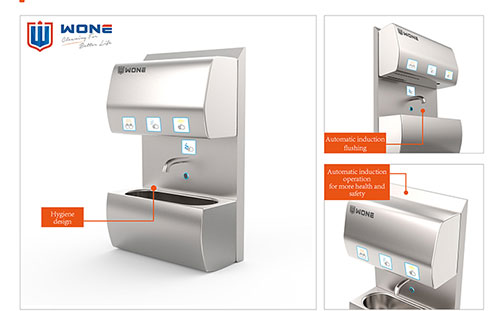Hand Hygiene Stations Recommended in Public Areas by WHO
 In recent years, the importance of hand hygiene has been widely recognized to prevent the spread of contagious diseases. With the outbreak of the COVID-19 pandemic, the significance of maintaining good hand hygiene practices has become even more critical. To minimize the transmission of not only COVID-19 but also other infectious diseases, the World Health Organization (WHO) has recommended the installation of hand hygiene stations in public areas. These stations play a vital role in promoting hand hygiene and protecting public health.
In recent years, the importance of hand hygiene has been widely recognized to prevent the spread of contagious diseases. With the outbreak of the COVID-19 pandemic, the significance of maintaining good hand hygiene practices has become even more critical. To minimize the transmission of not only COVID-19 but also other infectious diseases, the World Health Organization (WHO) has recommended the installation of hand hygiene stations in public areas. These stations play a vital role in promoting hand hygiene and protecting public health.
Hand hygiene stations are located in strategic areas
 Hand hygiene stations are specifically designed areas where individuals can wash their hands conveniently and effectively. They typically consist of a sink or basin for handwashing, soap or hand sanitizer dispensers, and equipment to dry hands properly, such as paper towels or hand dryers. Hand hygiene stations are located in strategic areas, including but not limited to hospitals, schools, airports, shopping malls, and office complexes. The aim is to ensure their accessibility to a large number of people, thus encouraging regular handwashing and reducing the risk of spreading harmful germs.
Hand hygiene stations are specifically designed areas where individuals can wash their hands conveniently and effectively. They typically consist of a sink or basin for handwashing, soap or hand sanitizer dispensers, and equipment to dry hands properly, such as paper towels or hand dryers. Hand hygiene stations are located in strategic areas, including but not limited to hospitals, schools, airports, shopping malls, and office complexes. The aim is to ensure their accessibility to a large number of people, thus encouraging regular handwashing and reducing the risk of spreading harmful germs.
Proper hand hygiene is the most effective way to prevent the transmission of germs
The WHO strongly recommends the installation of hand hygiene stations in public areas due to the numerous benefits they offer. Firstly, these stations act as a visual reminder for individuals to practice good hand hygiene. By making hand hygiene facilities easily accessible and visible, people are more likely to engage in regular handwashing. Proper hand hygiene is the most effective way to prevent the transmission of germs and reduce the risk of illnesses, such as respiratory infections, gastrointestinal diseases, and skin infections.
Educating the population about hand hygiene is paramount
Moreover, hand hygiene stations contribute to raising awareness about the importance of handwashing. By having these stations readily available in public areas, individuals are reminded of the importance of hand hygiene and are encouraged to make it a regular habit. This approach is especially crucial for children and young adults who may not yet have acquired these vital health habits. Educating the population about hand hygiene and its role in preventing diseases is paramount, and hand hygiene stations serve as a practical tool in achieving this objective.
Hand hygiene stations provide a sense of reassurance to the public
Hand hygiene stations also provide a sense of reassurance to the public, instilling confidence that their health and safety are being prioritized. Especially in high-traffic areas such as airports and hospitals, the presence of hand hygiene stations demonstrates a commitment to public health and hygiene standards. This reassurance is particularly valuable during pandemics or disease outbreaks when individuals may feel anxious about their personal safety.
Guidelines for hand hygiene station proper installation and maintenance
To ensure the effectiveness of hand hygiene stations, the WHO provides guidelines for their proper installation and maintenance. These recommendations include placing stations at convenient locations with high visibility, ensuring a sufficient supply of soap or sanitizer, and regular cleaning and refilling of dispensers. Training staff members responsible for monitoring and maintaining the stations is also vital to guarantee their optimal functioning. Following these guidelines not only ensures the practicality of the stations but also enhances their impact on hand hygiene practices.
The cost of hand hygiene station
However, it is essential to acknowledge that the installation and maintenance of hand hygiene stations entail some costs. The initial investment includes the purchase and installation of the stations, as well as providing a constant supply of soap, sanitizers, and other necessary materials. Routine maintenance, cleaning, and monitoring also require resources. Despite these costs, the implementation of hand hygiene stations is far outweighed by the benefits they bring in terms of disease prevention and public health promotion.
In conclusion, hand hygiene stations recommended by the WHO are crucial in promoting and maintaining good hand hygiene practices in public areas. Their strategic placement, visibility, and convenience act as reminders to individuals to regularly wash their hands and prevent the transmission of contagious diseases. By raising awareness and providing reassurance, these stations play a vital role in protecting public health, especially during the ongoing COVID-19 pandemic. Although the installation and maintenance of these stations involve costs, the benefits they deliver in terms of disease prevention and public health promotion make them a worthwhile investment. Let us embrace the importance of hand hygiene and support the installation of hand hygiene stations in public areas for the greater well-being of our communities.


